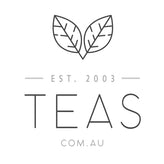Teabags vs Loose Leaf Tea
Posted by BEV A

There’s a lot of talk about why leaf teas (such as “loose-leaf tea” and “whole-leaf tea”) are better than teabags. While some of it is true, most of it is made up of broad generalizations, like “Loose-leaf tea is always better than teabags.” Learn what differentiates teabags from leaf teas, why leaf tea is usually better than teabags and how to make the switch from teabags to loose-leaf tea.

teabag content vs leaf tea
Whole-Leaf Tea vs. Teabags
“Whole-leaf tea” means tea that’s primarily made up of whole, unbroken leaves. Teabags are usually made from the opposite – low tea grades1, such as dust and fannings. Dust and fannings are smaller pieces of tea, so they have a larger surface area than whole leaves. A larger surface area means more opportunities for the essential oils (what makes tea flavourful and aromatic) to evaporate, leaving the tea dull and stale.
Freshness can be a major issue with typical teabags for this reason, especially if they are packed in a paper box with paper wrapping.Some types of tea (including many steamed Japanese green teas2) are naturally broken during processing. They are not technically whole leaf, even if they are at the pinnacle of quality. They also face some freshness issues, but loss of flavor is magnified with very small grades of tea (like dust and fannings).
Some teabags are made with whole-leaf tea. However, whole-leaf teabags are the exception rather than the rule.
Loose-Leaf Tea vs. Teabags
Loose-leaf tea is tea that is not brewed in a teabag. When you steep loose-leaf tea, it has (or should have) room for tealeaves to absorb water and expand as they infuse. This allows the water to flow through the leaves and extract a wide range of vitamins, minerals, flavors and aromas from the leaves.
When you steep tea in a teabag, its infusion is limited by the size of the teabag. Packing full-leaf tea into a small teabag won’t yield a very flavorful cup. For many years, the teabag industry adapted tea to the teabag. By filling teabags with smaller particles of tea (rather than whole leaves), the surface area and infusion rate of the tea were increased. A more flavorful (though not particularly nuanced) brew resulted. It was cheap, easy and good enough for your average “milk and sugar” tea drinker, so it was successful.
More recently, some tea merchants have decided to adapt the teabag to the tea. Instead of using flat-tasting grades of tea3 (tiny, broken leaves known as “dust” and “fannings”), they are opting for higher grades of tea with more sophisticated flavor profiles and aromas. They are getting better brews from these leaves than they would with traditional teabags by putting them into plus-size teabags, “tea pouches” and “tea socks,” as well as “pyramid bags” (pyramid-shaped teabags). All of these teabag variations allow the leaves to expand more than traditional teabags, thus creating a better brew.
Standardization vs. Variety
Despite these innovations in teabags, many tea connoisseurs still snub them for two main reasons. The first has to do with adherence to tradition and the enjoyment of tea rituals that do not include teabags. The second has to do with a more seasonal, artisanal, foodie approach to tea.
Typically, teabags are blended for standardization. Year to year, a particular grocery store tea will taste the same. This is because it’s blended with teas from around the world. Each year the quantities of teas from each location vary based on price and the final flavor profile the blenders are trying to attain. Often, a higher premium is placed on a tea’s price and standardization than on its quality and character of flavor profile.
Loose-leaf tea is frequently the opposite. Loose-leaf tea may be from a single region or even a single portion of a single estate. Its flavor, aroma and appearance vary from year to year and season to season. Generally, estates, regions, processing styles and growing seasons are known for particular flavors and aromas, but there is a far larger range of flavors and aromas available from loose-leaf tea than there is from standardized blends. This breadth and depth of tea profiles appeals to foodies (people who are very interested in food flavors and politics) as well as other obsessive types (as evidenced by the recent trend of tech stars turning to tea).
How to Switch to Leaf Tea
Leaf tea can seem overwhelming at first, but with the help of a friendly teashop (on an online tea retailer with good product information) and a few easy tips, finding and brewing teas you’ll love is easy.
First, think about what you like in tea and then seek it out in loose tea. If you prefer black tea, try black loose-leaf teas. If you like flavored teas, it’s OK to transition to flavored whole-leaf tea. Ask your local teashop for recommendations or check out different companies’ online offerings.
Then, figure out how you’ll brew your tea. There are a lot of choices, and some are better for certain types of tea than others. I suggest keeping it simple in the beginning. Here’s a list of five easy ways to brew leaf tea (including, yes, whole leaf tea in teabags).
Next, expand your horizons more. If you started with flavored leaf tea, be sure to try an unflavored tea every now and then, too. You may find you prefer it after your palate has developed a bit more! Don’t be afraid to try new and different suppliers. Consider investing in better teaware. And, above all, follow your tastes! If you drink what you love and infuse in something that’s beautiful and sensible for you, you’ll never look at teabags the same way again.
http://coffeetea.about.com/od/teaandtisanebasics/a/TeabagsVsLeafTea.htm
Writer: Lindsey Goodwin
Source: About.com Guide
SHARE:

AUSTRALIA'S FINEST LOOSE LEAF TEAS
Explore Australia's largest selection of Premium Teas & All-Natural Organic Herbal Blends.


